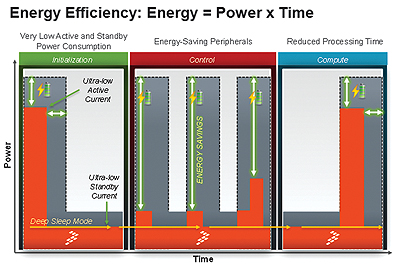In an embedded system, it is all about being more energy efficient across the application’s tasks, which can generally be broken into three phases: Initialization,


Control and the Compute. To reduce power consumption the equation is simple, reduce the area underneath the curve; in essence, do more with less power and time.
This is achieved by being best-in-class in not just one of these phases, but in all three.
By Justin Mortimer, Kinetis MCU product manager
Our ever-changing world of electronics
Electronics have made great strides since the first radio receiver/transmitter, a.k.a. the “walkie-talkie,” was introduced by Motorola in 1940. Since then, rapid advancements and breakthrough innovations continue to impact the way we interact with our world. We’re surrounded by embedded processors and sensors in battery-operated mobile devices like phones, tablets and other “smart” electronics. Ultimately, our world is driven by embedded software that constantly collects and interprets data to make real-time decisions. As consumers, we expect extremely high performance from our devices, and the growing expectation is that each product release will bring more functionality, longer battery life, lower prices, a better software experience, and a product safer for our environment. As the number of battery-operated devices increases, the importance placed on the embedded system to meet those requirements is that much greater. If you’re a design engineer, you know this all too well, which is why you will be glad to hear that the Kinetis MCUs are built around these requirements, especially power efficiency.
Kinetis microcontrollers are driving low power, even lower
In the past, integrated circuit manufacturers were pushed to deliver products with greater performance and integration. Today, expectations have been raised. Energy efficient appliances, electric vehicles, LED lighting and televisions started the trend, but devices are getting much smarter: they are starting to make autonomous decisions without human intervention. Smarter integration, performance efficiency and creative solutions to solve the low power challenge have become a top priority for the integrated circuit manufacturers.
The Kinetis MCUs have been built around reducing power consumption and will continue to differentiate themselves from other MCUs on the market.
Driving down power consumption, one device at a time
Here are just a few low power techniques integrated into the Kinetis portfolio, which help to reduce power consumption.
• Low power boot: Optimized for the lowest power during the boot process by providing non-volatile control bits to set default chip clocking upon device power up
• Smart clocking: Scalable performance, as needed to meet application needs, through various clock sources and multipliers to set the clocks for peripherals or CPU, across all power modes
• Ultra-efficient processing: Real-time control and computation through the use of the world’s most efficient processor cores, the ARM® Cortex®-M, supplemented by Freescale proprietary hardware accelerators
• Flexible low power modes: Numerous power modes to power gate memories and peripherals, allowing for dynamic and static power optimization that fits a wide range of use cases
• Autonomous, low power peripherals: Precious energy savings by enabling strategic peripherals to operate, and function with decision making capabilities, in power down modes, so that time spent sleeping can be extended
Kinetis MCUs can make a difference, and will be there to help when milliamps make a world of difference
Today’s embedded systems are not like the hardware-driven systems of our past. They are more complicated applications, with real-time tasks that include harvesting data from sensors, computing algorithms and making informed decisions. These applications require hardware that balances performance with power, but more so than ever, they require advanced software development. And as we move deeper into this new world, the need for power efficient devices is growing. The innovation driving the Kinetis portfolio is fueled by the desire to design microcontrollers that consume less power, offer flexible power modes, smarter peripherals, and tightly integrated software and enablement solutions. To keep up on what the team has been working on, you can check out Freescale.com/lowpower. As new power efficiency updates are made, we’ll share it here on the Embedded Beat ■
www.freescale.com


